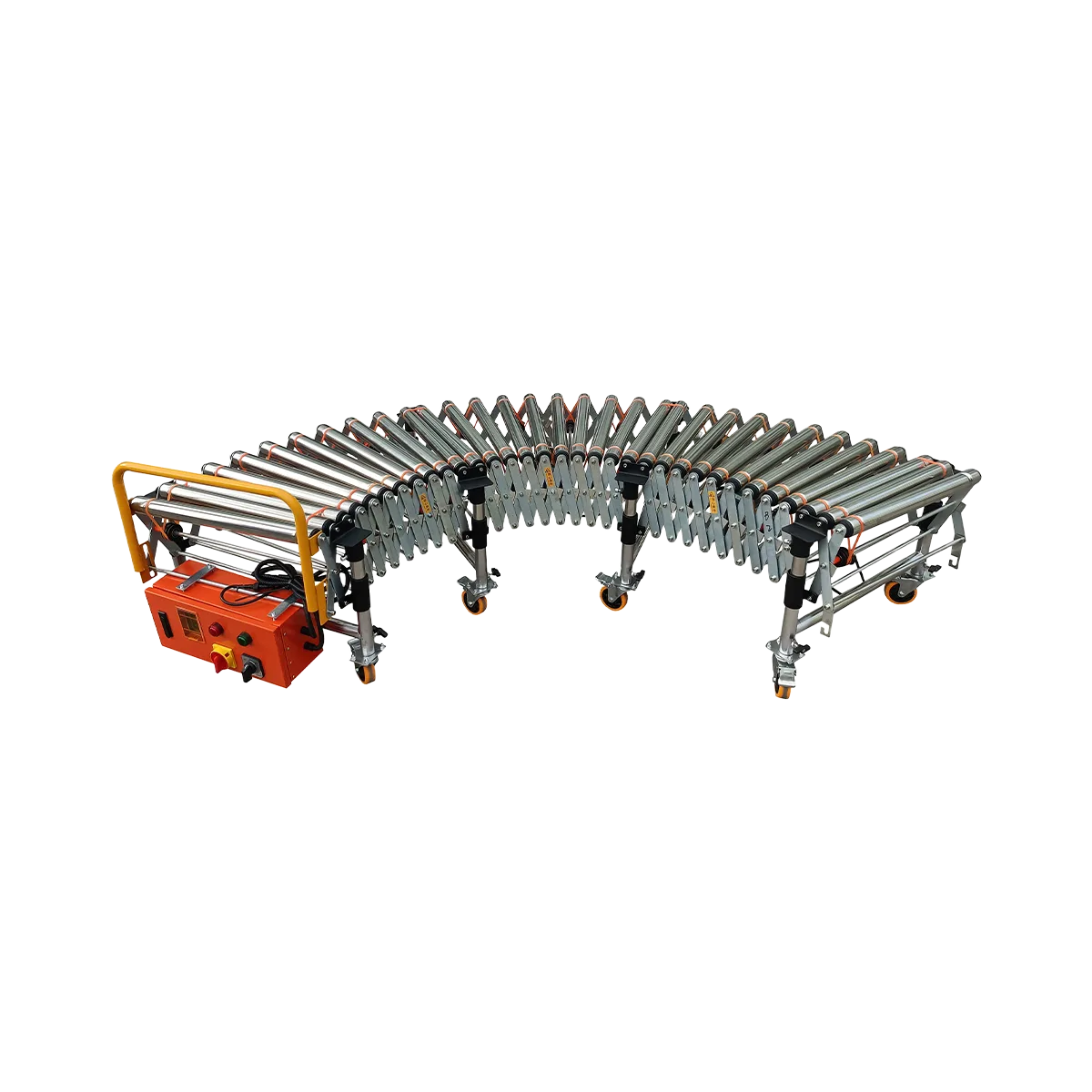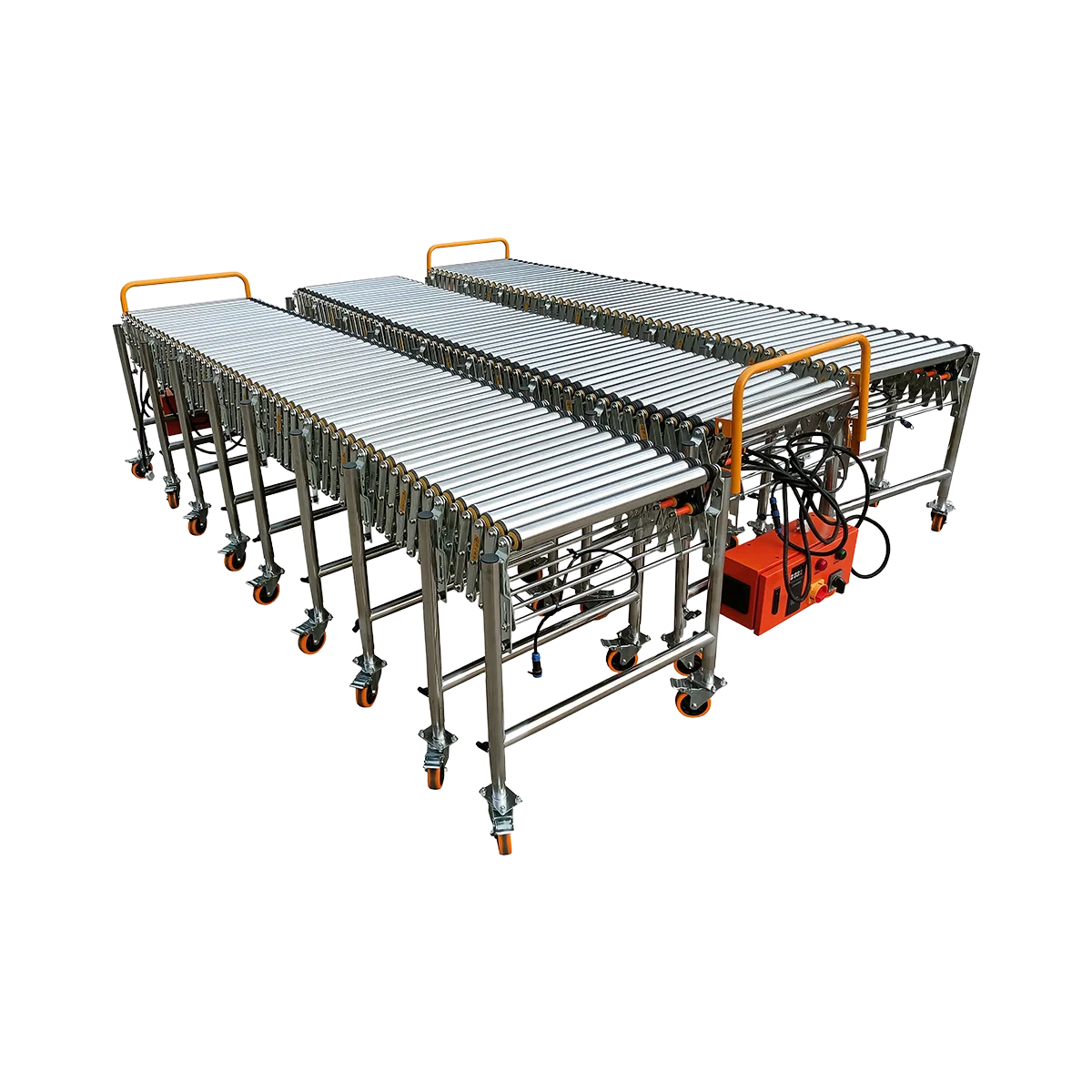Extending Your Sorting System to the Truck Door: A Guide to ‘Last-Mile’ Conveyors
Discover how the right conveyor system integration can bridge your sorter to the truck door, eliminating bottlenecks and maximizing your warehouse last-mile logistics efficiency.
Related Products
- Powered Roller Conveyor – O-shaped Belt Driven – 1500 mm/SectionCollapsed Length
525 mm
Extended Length1500 mm
Load Capacity80 kg/m
Applicable GoodsFlat-bottomed Goods
- Powered Roller Conveyor – Multi-wedge Belt Driven – 2000 mm/SectionCollapsed Length
700 mm
Extended Length2000 mm
Load Capacity100 kg/m
Applicable GoodsFlat-bottomed Goods
- Powered Roller Conveyor – Multi-wedge Belt Driven – 3000 mm/SectionCollapsed Length
1050 mm
Extended Length3000 mm
Load Capacity80 kg/m
Applicable GoodsFlat-bottomed Goods
Modern distribution centers invest millions in sophisticated sorting systems that can process thousands of packages per hour with remarkable accuracy. Yet many operations face a surprising bottleneck at the final stage of their process—the critical gap between the sorter’s output chute and the truck door. This conveyor system integration challenge represents the “last mile” of internal logistics, where the speed and efficiency of automated sorting often collides with manual handling processes. Without proper connectivity, workers must repeatedly carry or cart sorted packages from the end of the sorter to the loading area, creating a labor-intensive bottleneck that undermines the entire system’s performance.
The solution lies in creating a seamless bridge between your primary sorting system and the truck loading zone. By extending your automated material handling capability all the way to the truck door, you can maintain throughput consistency, reduce manual handling, and preserve the sorting accuracy you’ve worked so hard to achieve. This article explores how to effectively implement this critical “last-mile” connection using flexible, adaptable conveyor systems that integrate with your existing infrastructure.
The Bottleneck: Manually moving sorted parcels from the sorter’s chute to the truck
Despite significant investments in automated sorting technology, many operations still rely on manual methods for the final transfer of packages to trucks. This creates several operational challenges:
Labor Inefficiency
- Repetitive movement: Workers must repeatedly travel between the sorter output and truck door
- Physical strain: Continuous lifting and carrying leads to fatigue and potential injuries
- Staffing requirements: Multiple workers needed to keep pace with sorter output
- Productivity limitations: Human movement speed creates an inherent throughput ceiling
Process Disruption
- Speed mismatch: Sorter operates at consistent high speed while manual movement varies
- Accumulation problems: Packages pile up at sorter outputs during peak periods
- Flow interruptions: Workers must pause to organize loads, creating stop-start patterns
- Capacity constraints: Limited by how much a worker can physically carry per trip
Quality Concerns
- Sorting integrity: Carefully sorted packages may get mixed during manual transfer
- Package handling: Increased touching points raises damage risk
- Tracking challenges: Manual movement creates visibility gaps in the logistics chain
- Error introduction: Packages may be carried to incorrect loading doors
These challenges become particularly acute during peak periods when sorting systems operate at maximum capacity. The manual gap between sorter and truck effectively becomes the limiting factor for the entire operation’s throughput, undermining the substantial investment made in high-speed sorting technology.
The Bridge: Using a Naili Powered Roller Conveyor as a seamless connection
The ideal solution for bridging the gap between sorter output and truck door is the powered roller conveyor—a versatile, reliable system specifically designed to create seamless connections between different material handling zones. These conveyors offer several key advantages that make them particularly well-suited for this application:
Continuous Flow Maintenance
- Consistent speed: Variable frequency drives allow precise matching to sorter output rates
- Bidirectional capability: Can run in reverse if needed to clear jams or adjust flow
- Smooth transitions: Designed for seamless handoffs from sorting systems
- Uninterrupted movement: Eliminates the stop-start pattern of manual handling
Operational Flexibility
- Modular design: Sections can be added or removed as needed
- Multiple configurations: Available in various widths (500/600/800mm) to match sorter outputs
- Drive options: O-belt or multi-wedge belt systems for different load requirements
- Extendable sections: Available in lengths that extend from 525mm to 3000mm
Integration Capability
- Height adjustability: Support legs adjust to match existing sorter output heights
- Connection adaptability: Can be fitted with custom transition plates to connect with various sorter types
- Control compatibility: Can be integrated with existing control systems for synchronized operation
- Expandable design: Additional sections can be added as operational needs change
The powered roller conveyor serves as the critical backbone of the last-mile connection, providing the consistent, reliable movement needed to maintain the efficiency of the overall system. When properly implemented, it creates a seamless extension of your sorting capability all the way to the loading zone.
System Design: Creating a seamless path from sorter to truck
Implementing an effective end-of-line conveyor solution requires careful planning and proper system design. The ideal configuration typically involves three key components working together to create a continuous flow path.
Connecting the Powered Roller Conveyor intake directly to the sorter’s output
The first critical connection point is between the sorting system’s output chute and the powered conveyor:
- Custom transition plates: Specially designed metal plates create smooth transitions between different systems
- Height matching: Precise adjustment of conveyor height to align perfectly with sorter output
- Width alignment: Selecting the appropriate conveyor width (typically 600mm or 800mm) to match sorter output dimensions
- Speed synchronization: Setting conveyor speed to match or slightly exceed sorter discharge rate
For most applications, the multi-wedge belt driven powered roller conveyor provides the ideal intake solution due to its superior load capacity (100 kg/m) and consistent performance. The connection point should be designed to eliminate any gaps or drops that could cause package jams or misalignment.
Running the powered section to the loading dock door
Once packages transition from the sorter to the powered conveyor, they need a reliable path to the loading area:
- Straight-line efficiency: When possible, direct paths minimize transitions and potential jam points
- Curved sections: Where needed, powered curved sections maintain flow around corners
- Multiple powered zones: For longer distances, connecting several powered sections creates a continuous path
- Speed control: Variable frequency drives (0.75/1.5/2.2 kW) allow fine-tuning of transport speed
- Control integration: Emergency stops and controls positioned at key points along the path
The powered conveyor section should extend as close to the dock door as practically possible while still allowing for the final flexible extension into the truck. For most applications, bringing the powered section to within 1-2 meters of the dock door provides the optimal balance between fixed infrastructure and flexible loading capability.
Attaching a flexible gravity conveyor to extend into the truck
The final component of the system bridges the gap between the fixed facility infrastructure and the truck interior:
- Gravity roller conveyor: Provides a flexible extension that can reach into the truck
- Extendable design: Sections that collapse to 525mm but extend to 1500mm allow deep reach
- Slight decline: A gentle slope of 2-3 degrees helps packages travel smoothly into the truck
- Quick connection: Fast attachment/detachment from the powered section for rapid truck changeovers
- Adjustable height: Support legs that adjust to match various truck bed heights
For operations without loading docks, a hydraulic conveyor can be added between the powered section and the gravity extension, creating a complete system that bridges both horizontal and vertical gaps in the material flow.
This three-part system design—powered intake from sorter, powered transport to dock, and flexible extension into the truck—creates a complete “last-mile” solution that eliminates manual handling while maintaining system throughput.
The Benefits: Maintaining system speed, reducing manual labor, and minimizing sorting errors post-sort
Implementing a proper warehouse last-mile logistics solution delivers multiple operational benefits that impact both efficiency and accuracy:
Throughput Consistency
- Elimination of bottlenecks: The entire system operates at consistent speed without manual slowdowns
- Peak capacity handling: Maintains flow even during high-volume periods
- Reduced congestion: Prevents package buildup at sorter discharge points
- Continuous operation: Minimizes stops and starts that disrupt overall system rhythm
Labor Optimization
- Reduced handling: Packages move from sorter to truck with minimal human intervention
- Staff reallocation: Workers can be reassigned from repetitive carrying tasks to higher-value activities
- Injury prevention: Decreases lifting and repetitive motion injuries
- Productivity improvement: Fewer workers can manage higher package volumes
Quality Preservation
- Maintained sortation: Packages remain in their sorted order all the way to the truck
- Reduced damage: Consistent conveyor transport is gentler than manual handling
- Error reduction: Eliminates mis-routing of packages during manual transfer
- Enhanced tracking: Provides continuous visibility throughout the entire process
Operational Metrics
The impact of implementing a proper conveyor extension system can be measured in several key performance indicators:
| Metric | Typical Improvement |
|---|---|
| Packages per labor hour | 30-50% increase |
| Dock-to-stock time | 20-40% reduction |
| Error rates | 50-70% reduction |
| Worker steps per shift | 60-80% reduction |
| Loading time per truck | 15-30% reduction |
These improvements directly translate to bottom-line benefits, with most operations achieving return on investment within 6-12 months through labor savings and efficiency improvements alone.
Conclusion: Don’t let the last 50 feet be the slowest part of your process. Integrate with Naili.
The sophistication and speed of modern sorting systems deserve to be matched with equally efficient “last-mile” material handling solutions. By implementing a properly designed powered roller conveyor extension system, operations can eliminate the final manual bottleneck and create truly end-to-end automation in their package handling process.
The key to successful implementation lies in selecting the right components and configuring them to work seamlessly with your existing infrastructure. The modular, adaptable nature of Naili’s conveyor systems makes them particularly well-suited for this application, offering:
- Seamless integration with existing sorting systems
- Flexible configuration to match your specific facility layout
- Scalable capacity to handle peak volumes
- Reliable performance with minimal maintenance requirements
- Quick implementation with minimal disruption to ongoing operations
Don’t let the final 50 feet of your process undermine the efficiency of your entire sorting operation. By extending your automated material handling capability all the way to the truck door, you can maximize the return on your sorting system investment while creating a more efficient, ergonomic, and error-free operation.
Frequently Asked Questions
How do I determine the right conveyor width to match my sorter output?
Measure the width of your sorter’s output chute and select a conveyor that is equal to or slightly wider than this measurement. For most sorting systems, the 600mm or 800mm width powered roller conveyor provides the optimal match. If packages frequently exceed 500mm in width, the 800mm conveyor is recommended.
Can the conveyor system be integrated with our existing control systems?
Yes, the powered roller conveyor systems can be integrated with most existing warehouse control systems. The standard control panels include connections for external control signals, allowing for synchronized operation with your sorter. For more complex integration requirements, custom control solutions are available.
What is the maximum distance we can extend from the sorter to the truck?
There is no practical limit to the distance you can cover with powered roller conveyors. For longer distances, multiple powered sections can be connected in sequence. The key consideration is maintaining appropriate power distribution and control integration throughout the system. Systems extending 50+ meters from sorter to dock door are common and function effectively.
How quickly can we switch the flexible end section between different loading doors?
With proper design and training, workers can disconnect the flexible gravity conveyor section from one powered line and reconnect it to another in approximately 2-3 minutes. This allows for rapid redeployment as loading requirements change throughout the day. For operations with multiple simultaneous loading positions, dedicated flexible sections for each door eliminate transition time entirely.
What maintenance is required for the conveyor extension system?
Maintenance requirements are minimal. The powered roller sections need monthly checks of drive belts, rollers, and bearings. The gravity sections require only quarterly inspection of rollers and bearings. With proper maintenance, these systems typically provide 5-10 years of reliable service before requiring significant component replacement.
Table of Contents
Recent Posts
Optimize hardware store logistics with the right building supply conveyor systems. Our guide to tool distribution systems enhances retail warehouse automation for efficient operations.
Optimize your medical supply logistics with efficient gravity conveyor systems. Learn how to safely handle healthcare products while improving your hospital supply chain operations.
Discover how a sports equipment conveyor system can streamline your athletic gear logistics. Flexible conveyor solutions for all shapes and sizes of sporting goods.



